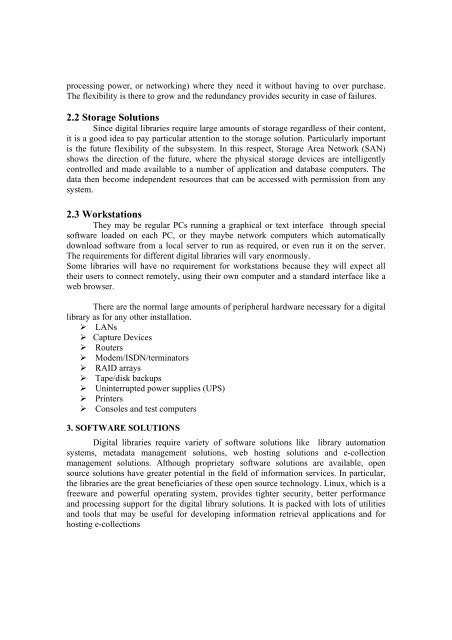READIT - 2009 - Indira Gandhi Centre for Atomic Research
READIT - 2009 - Indira Gandhi Centre for Atomic Research
READIT - 2009 - Indira Gandhi Centre for Atomic Research
Create successful ePaper yourself
Turn your PDF publications into a flip-book with our unique Google optimized e-Paper software.
processing power, or networking) where they need it without having to over purchase.<br />
The flexibility is there to grow and the redundancy provides security in case of failures.<br />
2.2 Storage Solutions<br />
Since digital libraries require large amounts of storage regardless of their content,<br />
it is a good idea to pay particular attention to the storage solution. Particularly important<br />
is the future flexibility of the subsystem. In this respect, Storage Area Network (SAN)<br />
shows the direction of the future, where the physical storage devices are intelligently<br />
controlled and made available to a number of application and database computers. The<br />
data then become independent resources that can be accessed with permission from any<br />
system.<br />
2.3 Workstations<br />
They may be regular PCs running a graphical or text interface through special<br />
software loaded on each PC, or they maybe network computers which automatically<br />
download software from a local server to run as required, or even run it on the server.<br />
The requirements <strong>for</strong> different digital libraries will vary enormously.<br />
Some libraries will have no requirement <strong>for</strong> workstations because they will expect all<br />
their users to connect remotely, using their own computer and a standard interface like a<br />
web browser.<br />
There are the normal large amounts of peripheral hardware necessary <strong>for</strong> a digital<br />
library as <strong>for</strong> any other installation.<br />
‣ LANs<br />
‣ Capture Devices<br />
‣ Routers<br />
‣ Modem/ISDN/terminators<br />
‣ RAID arrays<br />
‣ Tape/disk backups<br />
‣ Uninterrupted power supplies (UPS)<br />
‣ Printers<br />
‣ Consoles and test computers<br />
3. SOFTWARE SOLUTIONS<br />
Digital libraries require variety of software solutions like library automation<br />
systems, metadata management solutions, web hosting solutions and e-collection<br />
management solutions. Although proprietary software solutions are available, open<br />
source solutions have greater potential in the field of in<strong>for</strong>mation services. In particular,<br />
the libraries are the great beneficiaries of these open source technology. Linux, which is a<br />
freeware and powerful operating system, provides tighter security, better per<strong>for</strong>mance<br />
and processing support <strong>for</strong> the digital library solutions. It is packed with lots of utilities<br />
and tools that may be useful <strong>for</strong> developing in<strong>for</strong>mation retrieval applications and <strong>for</strong><br />
hosting e-collections

















